皮皮蝦
Will update later on.说明:
《是谁夺走了美国人的数学能力--美国百年数学战争演义》系列在
Why Has PAUSD Failed in Closing the Achievement Gap or Reducing Stress?
- The Persistent Achievement Gap in PAUSD
For more than a decade, the Palo Alto Unified School District (PAUSD) of California has strived for two goals: closing the achievement gap and reducing stress. However, recent statistics still show stark academic achievement gaps among ethnic groups, and one in five teens experience a diagnosable mental health issue. While 81 percent of Asian students met or exceeded state math standards, this number dwindles to 16 percent for the economically disadvantaged group, which includes hundreds of East Palo Alto students studying at the Palo Alto schools via the Voluntary Transfer Program (VTP)—a “closing the achievement gap" program launched in 1986.

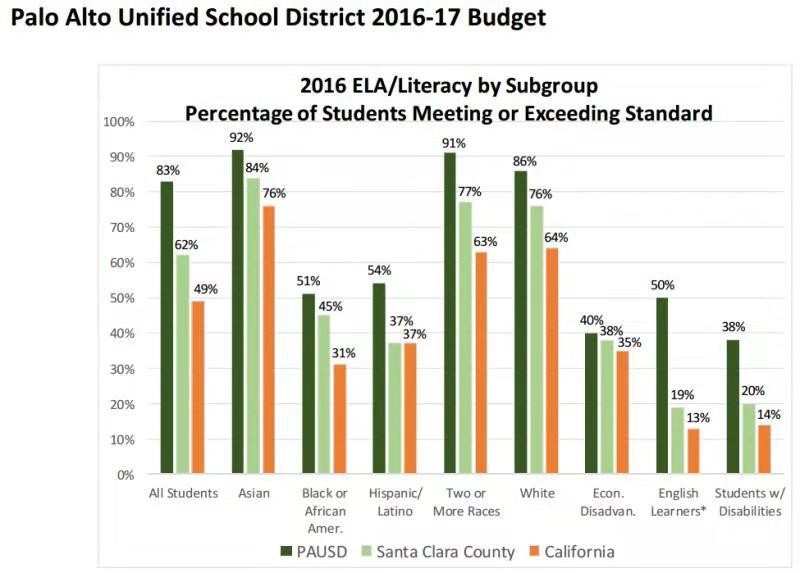
(Source: https://www.pausd.org/sites/default/files/pdf-faqs/attachments/BudgetBook2016-17.pdf )
Meanwhile, a substantial amount of PAUSD students are taking supplemental studies, as seen by the following Nextdoor screenshot. Built upon supplemental studies, many students—especially Asian ones—are taking honor and AP courses or skipping grades. This has added extra pressure on all students, causing an atmosphere of unhealthy and unfair academic arms races in Palo Alto—an observation disturbing to many Palo Altans.
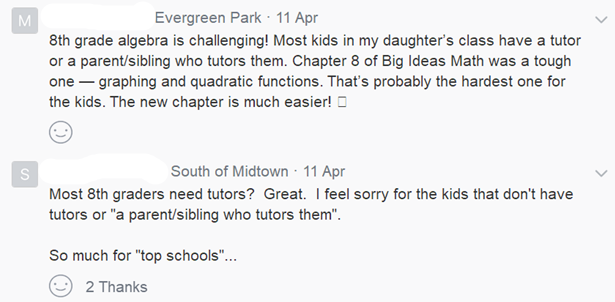
This essay shares some perspectives on understanding why PAUSD, like many other school districts, has inevitably failed in closing the academic achievement gap, what the root causes of school stress are, and why parents engage their kids in supplemental studies. This essay is not meant to slight our respectful teachers. In fact, both teachers and students are undermined by a host of false education doctrines entwined with anti-intellectualism. It is hoped that the message from this essay will prompt the readers to ponder how to pitch in to fight against the persistent anti-intellectualism prevailing in American K-12 education and to save America as a land of hope and liberty.
- Drowning in Mediocrity
Unsurprisingly, the above diagrams reveal that PAUSD's biggest academic achievement gap lies in math, which epitomizes the epidemic poor math accomplishment across the 15,000 U.S. public school districts. For the past half-century, America has suffered failure in all endeavors to improve math education. In 1957, the launch of Sputnik spurred public anxiety about America’s math and science education quality. In 1983, the landmark report A Nation at Risk famously spoke of the “rising tide of mediocrity” that threatened American schools. In 2013, the U.S. Department of Education report For Each and Every Child lamented that:
Nearly 30 years later, the tide has come in—and we're drowning … We have had five 'education presidents' and dozens of 'education governors' who have championed higher standards, innovative schools, better teaching, rigorous curricula, tougher testing and other education reforms … Americans have debated how to approach our education system and have called for reforms of every description.
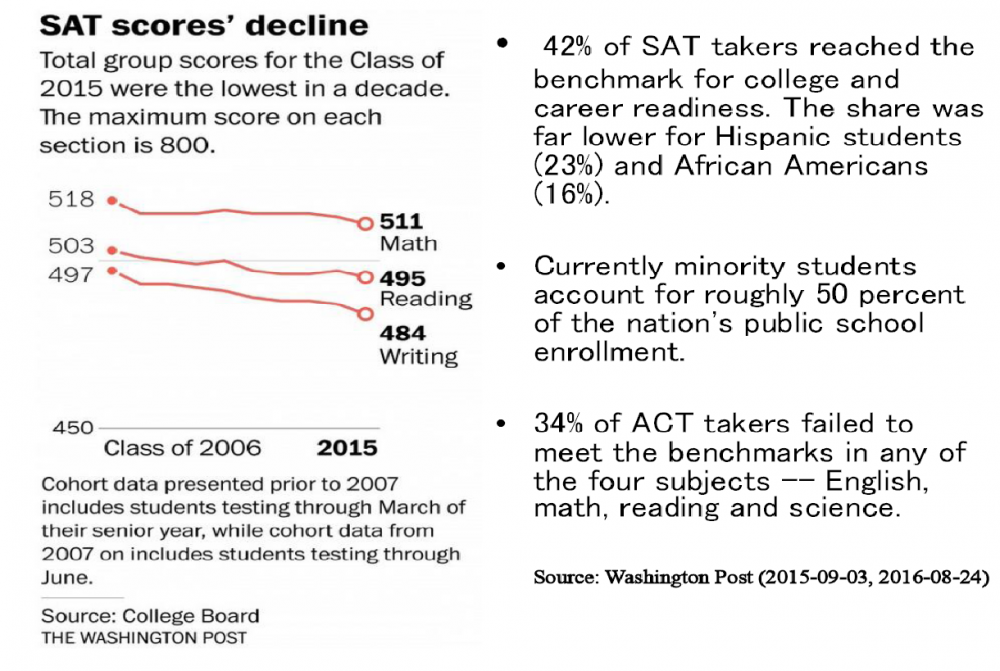


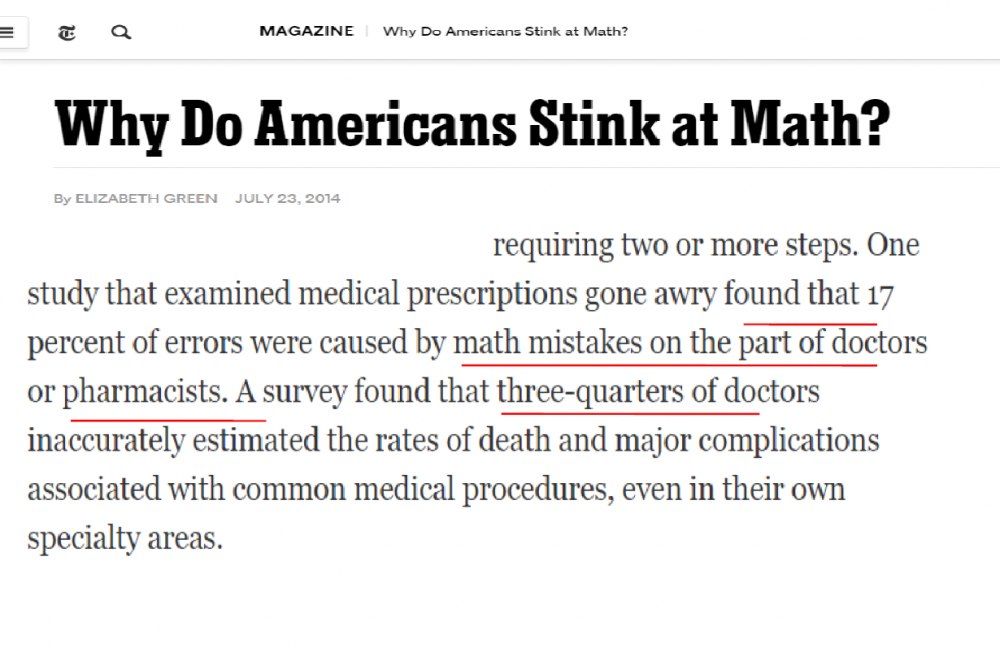
These screenshots paint a bleak picture of America's math education: over the past decades, American students' math performance has been unstoppably declining. How has math education become a nearly unsolvable problem for America? PAUSD's intriguing experiences may offer us a clue to this perplexing question.
- Historical “Math Wars” in Palo Alto
For more than half a century, the prestigious Palo Alto school district, which serves nearly 12,000 students in the affluent town annexing the Stanford University, has periodically relapsed into a battlefield of "math wars.”
In 1974, at the height of the Open Education Movement, Palo Alto parents urged the school district to open a "back-to-basics" elementary school—the Hoover Elementary. Parents flocked to camp in the park to vie for a slot in this school for their children.
In 1994, more than 600 parents signed a petition to fight against the school district's replacement of a traditional math curriculum with a reform math program. In early 1995, 25 Palo Alto parents founded HOLD (Honest Open Logical Debate), a math advocacy organization which has inspired waves of grassroots math advocacy movement in school districts near and afar, including the founding of a sister organization—the NYC HOLD National (http://www.nychold.com/) by New York City parents. HOLD's mailing list soon expanded to include nearly 500 households, including former President of the Mathematical Association of America, Henry Alder. HOLD reported that students’ test scores deteriorated with the implementation of "whole math" in district schools; 63 percent of Palo Alto parents had to provide outside math tutoring for their middle school children, the sum of expenses amounting to at least $1 million a year.
In 1997, a draft of California math standards written by a committee of educational professionals was submitted to the State Board of Education for final approval. Finding that the draft was saturated with "constructivism" methods, incoherent, and full of mathematical errors, the State Board charged Stanford University math professors Carlsson, Cohen, Kerckhoff, and Milgram to rewrite the standards. The resulting new standards were competitive with those of the highest performing countries, and they had guided the significant improvement in California students' math performance between 1997 and 2014. But soon after their adoption, the new standards were openly resisted and attacked by the educational community, which invited more than 100 math professors, including chairs of the math departments at Caltech, Stanford, and several UC and CSU campuses, to voice their support for the new standards in an open letter.
In 2009, despite a petition signed by more than 700 residents, the PAUSD adopted Everyday Math among enthusiastic support from local teachers.
(https://www.paloaltoonline.com/news/2009/04/29/palo-alto-schools-to-get-everyday-mathematics)

In 2016, PAUSD dropped Everyday Math after using it for seven years. Parents lament that this curriculum "has left so many kids struggling with math.”
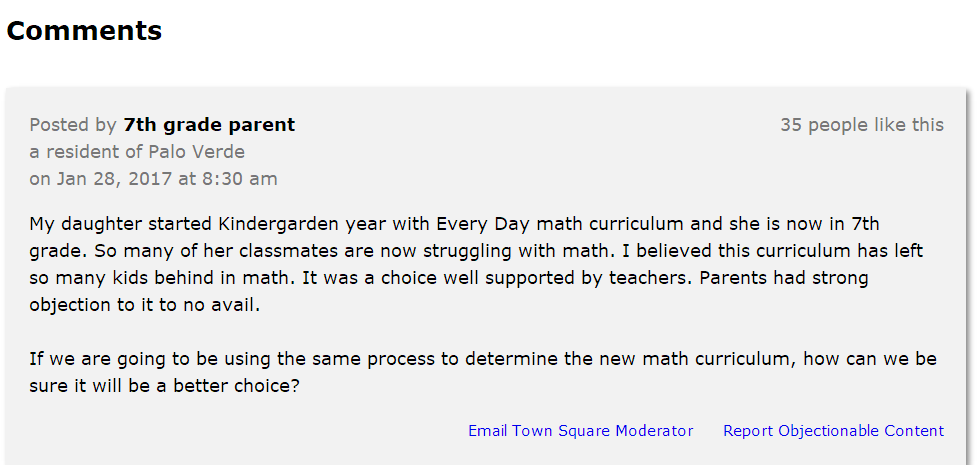
Which replacement curriculum will PAUSD choose? Apparently, many local teachers enthusiastically recommended piloting Investigations, starting early 2017:
(https://paloaltoonline.com/news/2016/09/02/palo-alto-school-district-committee-drops-everyday-math)

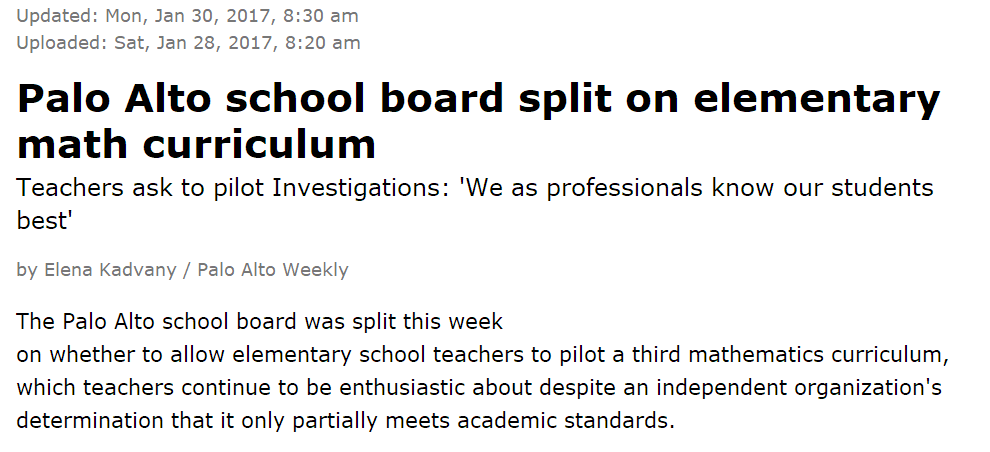
PAUSD is not alone in disputing with parents over controversial math curricula. In 2017, a few parents of Pleasanton school district launched a petition to remove College Preparatory Mathematics (CPM) from their schools. CPM is one of the Discovery Math curricula developed by American educators in the 1960s. The 2015 Canadian report What to Do about Canada's Declining Math Scores (Stokke, 2015) reveals that Discovery Math curricula caused a significant decline in Canadian students' math ability. For example, barely one-third of the kids circled the correct answer to the multiple-choice question of "1/3-1/4," which is slightly better than guessing.
As documented on the website of the New York City HOLD National, Investigations, Everyday Math, and CPM are among the most controversial curricula that ignited widespread "math wars" in the 1990s. Everyday Math and CPM belong to the ten defective math curricula recommended by the Department of Education to nationwide school districts in late 1999, which soon triggered an open letter of protest by 220 mathematicians and scientists, including seven Nobel Laureates and Fields Medalists (http://www.csun.edu/~vcmth00m/riley.html). And Investigations is a curriculum even weaker than Everyday Math.
What could have motivated the educational professionals to write and promote these defective textbooks? Why do the teachers favor them? Why did math wars recur and why did mathematicians (math PhDs) want to antagonize math education professionals (math education PhDs trained in education schools)?
We need to study a bit of Jean-Jacques Rousseau, the iconic Enlightenment thinker, to answer these questions.
- Origin of Low Standards and False Pedagogies of U.S. K-12 Math Education
Freedom, equality, and democracy were the main Enlightenment themes. Among the famous Enlightenment thinkers, Rousseau distinguished himself from others by championing collectivism (the individual's freedom should be subordinated to national interests), radical equality (equal socioeconomic outcome rather than equal opportunity), and direct democracy (different from representative democracy). While his political ideology forms the cornerstone for political progressivism, Rousseau's naturalistic, child-centered education thoughts cast the soul of progressive pedagogy. Rousseau's political and pedagogical progressivism were inherited and developed by his European disciples, including Hegel and Pestalozzi, and by the leading American progressive educators Dewey and Thorndike, among others. Rousseau's collectivism inspired Dewey's "school-to-work" philosophy, which claims that American public education should give up its classical tradition to aim at producing a future workforce. Rousseau's utopian idealism of radical equality prompted the progressive educators' pursuit of equal academic achievement across all students, which underpins the calling for "closing the achievement gap" in American public schools.
Apart from the political and pedagogical sides, the American progressive education model derived its third wing—administrative progressivism—from racial and gender prejudice, utilitarianism and pragmatism perspectives, and social efficiency pursuits prevailing in the early 20th century of America.
Terman, Cubberley, and Thorndike mistakenly believed that females and minorities had a lower IQ than white males and thus could not master advanced math. Kilpatrick asserted that math is "harmful rather than helpful to the kind of thinking necessary for an ordinary living," and Snedden claimed that Algebra "is a nonfunctional and nearly valueless subject for 90 percent of all boys and 99 percent of all girls" (Klein 2001, 2003). Bobbit and Snedden advocated tracking students by IQ, race, or gender and eliminating any useless subject materials—such as Latin and advanced math—to maximize education efficiency.
Progressive educators view equal academic achievement as a characteristic of democracy and equality, a calling of social justice. This view, coupled with their racial and gender biases, compelled them to conclude that traditional math curriculum was a threat to social justice because it supported the creation of intellectual elitism and a more stratified society through its filtering methods and high rates of failure. Hence, in the name of social justice, progressive reformers called for reforming math education to make it more accessible to minority and female students.
Consequently, school-to-work, teaching only useful materials, equal academic achievement for all students, prejudice over female and minority students' academic abilities, and naturalistic, child-centered education—all these progressivism beliefs had corroborated to set a tone of low expectations and lax academic standards for American public education in the early 20th century, and these beliefs, expectations, and standards have gradually prevailed in most public schools since then.
Since the Progressive Era, American public schools have been "educational expert's paradises," taking rollercoaster rides of the Activity Movement in the 1930s, the Life Adjustment Movement in the 1940s, the Open Education Movement in the 1970s, and the standards-based reforms initiated in the 1980s and culminating in the Common Core State Standards in the 21st century. Alongside these movements, American schools have experimented a kaleidoscope of educational experts' pedagogy innovations, such as Dewey's "learning-by-doing," Kilpatrick's "critical thinking" and "project method,”Bloom's "higher-order thinking," Bruner's "discovery learning," Piaget's "constructivism," and the current fads of "project-based learning," "personalized learning," "deeper learning," and “21st century skills."
These terms are immensely appealing to naïve minds because the public naturally respect and trust education experts, especially those from prestigious universities. However, no matter how scientific they sound, all these "innovations" are variants and descendants of Rousseau's naturalistic, child-centered education doctrines, which favor a slow-paced, self-inquiry, fragmented, and spiraling style of learning while dismissing learning basic facts and skills as "rote memorization" or "lower-order thinking." While these progressive pedagogies could be beneficial if used wisely only to augment academic, content-based study, they have been harnessed to cover up diluted curricula and reductionist teaching style in our schools.
Undergoing successive waves of progressive education movements, the American school math curricula have gradually disintegrated from the traditional "core-subject" structure to a "strands" structure, featuring a diluted, incoherent, and mile-wide, inch-deep content, which would alienate most children and cripple their math abilities (Ma, 1999). Everyday Math, Investigations, and College Preparatory Mathematics exemplify a host of such defective, math-free math textbooks that have been widely used in American schools. Such defective, diluted curriculum, coupled with reductionist-type of teaching and inadequate practices, would inevitably send most students onto a math-science death march.

E.D. Hirsch, a 90-year old American educator who authored Why Knowledge Matters: Rescuing Our Children from Failed Educational Theories and The Schools We Need: And Why We Don't Have Them compiled a list of "Education Terminology Every Parent Must Understand" (http://www.nychold.com/hirsch-termin.html) to inform the public of the true meaning of those eye-catching educational fads. Hirsch also inspired the U.K. education officials to value content-based education, which has led to the recent adoption of the Shanghai Math programs in thousands of British schools. The following link also offers a critical guide to the terms, phrases, and slogans widely used by the American educational community:

When talking about progressive education, most people would think of only its pedagogical side, thus concluding it is a historical or non-mainstream scene. However, we should not neglect the political or administrative sides of progressive education. Low academic standards resulting from political progressivism and administrative progressivism have never wandered away from the center stage of our public education system, even though progressive pedagogies come and go.
Low expectations and deficient curricula may reinforce with each other—low academic standards accommodate slow-paced, incoherent, and mile-wide, inch-deep curricula, causing learning inefficacy for the students; frustrated educators would further lower their expectations for students and favor even simpler, more watered-down curricula. Such a vicious cycle decides that American math education failure is an inevitable consequence rather than a mishap or anomaly.
However, the ever-deteriorating math performance of U.S. students has never stopped the educational professionals from concocting numerous "research-based findings" to support their false pedagogy and justify their deficient textbooks. They keep leading the teachers and administrators of U.S. schools astray even though their papers are almost completely unsupported with replicable data analysis.
Anti-intellectualism has undermined academic rigor of other subjects as well. As shown in the figure above, the average SAT scores of reading and writing has been monotonically declining over the past decade, which actually hit a historic low in the past half century. Such disheartening trends are no surprise. According to Ravitch (2000), leading professional organizations like the National Council of Teachers of English have de-emphasized teaching vocabulary, grammar, syntax, and the importance of close reading since long time ago, and the vocabulary of textbooks in almost every subject has been diluted over recent decades.
People are fond of envying Finland's education miracle, which boasts no homework, no exam, and marvelous school performance. However, as early as in 2005, more than 200 Finland mathematicians and scientists issued an open letter to call attention to "severe shortcomings in Finnish mathematics skills" (Tarvenan & Kivelä, 2005). Recent test results are not merciful towards the Finnish "Happy Education" legend either: Finland students scored even below their American peers in the 2015 TIMSS, a much more reliable test of students' math capacity than the better-known PISA, which tests mainly on math literacy (Bishop, 2017).
- The Mediocrity of the Common Core Math Standards
The Common Core State Standards (CCSS), the first de facto national education standards, started to roll out nationwide in 2010, with the promise to empower American students to catch up with the international high performers. Being deeply rooted in progressivism, however, the Common Core math standards were set at a mediocre level with low expectations on the students, thus further exacerbating the learning plight for American students.
In his "Dear Hillary Letter" of 1992, Marc Tucker, the National Center on Education and the Economy (NCEE) president and the chief architect of CCSS, envisioned a goal "to remold the entire American system for human resource development." He proposed that "what is essential is that we create a seamless web of opportunities to develop one's skills that literally extends from cradle to grave and is the same system for everyone—young and old, poor and rich, worker and full-time student." In Tucker's vision, American schools should aim to prepare the majority—eighty percent or more—of American high school students for the future workforce through career education modeled on an essentially Prussian apprenticeship system. Tucker's "school-to-work" blueprint reflects his firm conviction about the Rousseau-Hegel-Dewey collectivism.
Marc Tucker and his colleagues believe that "fewer than five percent of American workers and an even smaller percentage of community college students will ever need to master the courses in this sequence in their college or the workplace." Therefore, they set Algebra 1 as the high school graduation requirement, on the justification that "for most of our students, those 'high' standards in mathematics constitute a requirement to learn material they will never need, either in college or later in their work, a bit like the requirement a century ago to learn Latin in high school" (NCEE, 2013)
Such collectivism and equality convictions had compelled the Common Core architects to boldly jettison Algebra 2 and higher-level math courses from high school math standards and set Algebra 1 as the exit requirement for all American students, without a fear for devastating America's STEM future. What is more, on the calling of the sacred tenet of equality and the "soft bigotry of low expectations, "the architects also strived to restructure algebra courses to make them more accessible to all students.
However, even such a modest goal of Algebra 1 will be unattainable for the majority of students because the Common Core math standards champion those false progressive pedagogies. They prescribed a procrastinated, spiraling K-8 curriculum, which would put American students at least one or two grades behind the high-performing countries. While continuing to de-emphasize arithmetic skills, the Common Core standards went even more extreme with the "higher-order thinking," "conceptual understanding" fallacies than the previous fads. The Common Core-aligned textbooks require students to write verbosely about how they understand or solve math problems, thus turning math practices into writing or communicating exercises. Marina Ratner, the late math professor of UC Berkeley, made the following critiques about the Common Core (Ratner, 2013):
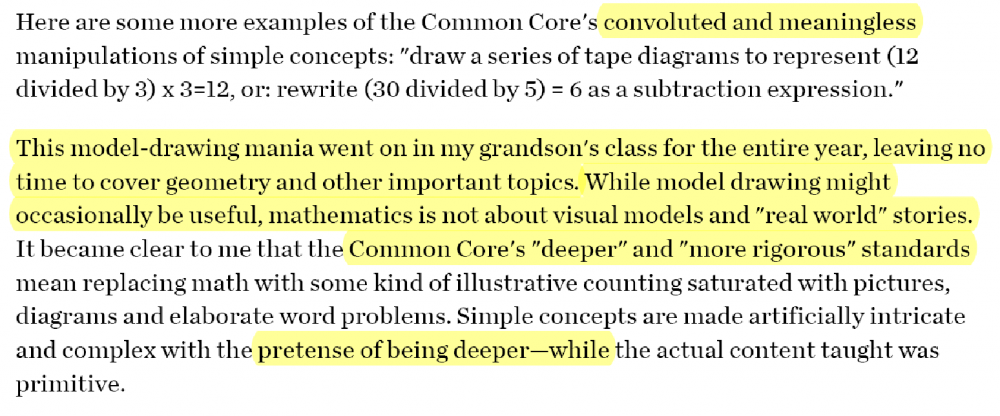
Jason Zimba, the lead writer of the Common Core math standard, acknowledged in 2013 that Common Core is "not only not for STEM" careers "but also not for selective colleges." In 2014, the College Board announced a decision to align the SAT with the Common Core State Standards with the goal to "bridge economic and demographic barriers." Thus, in order to deem more students as college- or career-ready, the College Board lowered the bar for college admission. Data shows that high school graduates equipped with Algebra 2 will have a mere 2 percent chance to attain a STEM degree in the future (Milgram & Stotsky 2013). While more than 40 percent of American students aspire for a STEM career, more than 50 percent of college freshmen drop out of STEM fields due to a weak math background, and most STEM graduate students in U.S. universities are from foreign countries. All this manifests that the U.S. K-12 education is a math-science death march. By dismantling high-school math courses, the Common Core is multiplying the casualties along the march.
An old Chinese proverb says, "Aiming high, one will likely reach middle; aiming middle, one will likely land low; aiming low, one will likely attain nothing." The mediocre Common Core math standards will leave most of the American students subpar in today's world.
- PAUSD's Academic Achievement Gap and Stress Myth
Palo Alto is famous for many prestigious reasons: neighboring Stanford University, the birthplace of Silicon Valley, high-tech elite residents, and top-tier public schools that have attracted families migrating here from across the globe.
Much less well-known are the historical Palo Alto "math wars." The dazzling school-rankings and satisfying test scores have reassured parents of the academic excellence in the Palo Alto school district. However, when their children rose to high school, many parents suddenly found their kids struggling with math. Academic stress loomed in and escalated along their children's 9-12 grades. Meanwhile, many students are soaring by taking honor and AP courses, skipping grades, and excelling in high-profile academic contests. Some adults stated that these high-achieving kids, via massive after-school studies, were waging an academic arms race and exacerbating school stress. They pressured the school district to react by limiting access to AP courses and adopting un-weighted GPA.
But students are taking supplemental studies for good reasons. Most PAUSD teachers are loving, caring, and hard-working. However, constrained by low standards, dysfunctional curricula, and progressive pedagogies, even the most caring teachers are unlikely to deliver satisfactory teaching outcomes. Like in most other school districts, math instruction of the K-8 grades in PAUSD is weak, flawed, and potentially a "math-science death march." Startled by their kids' poor basic skills and meager knowledge learned from school, many Palo Alto parents rationally intervened early to prop up their children's academic capacity with supplemental studies. While the math courses offered in PAUSD's high schools are of decent rigor by American standards, their fast-paced and wide-ranging nature, resulting from the spiraling, distributed theories of the educational professions, make math study intrinsically challenging for most learners. Hence, supplemental study becomes a necessity-- instead of a hostile academic arms race--for any normal kid who wants to learn the high school courses with calm and confidence. It is the correct perception of school education deficiency that compels parents to engage their children in after-school studies, which incurs handsome financial and logistic costs while adding stress on students and shrinking their scope for non-academic pursuits. Unfortunately, many parents who trusted the fame of the school district and test scores did not realize that PAUSD's weak K-8 math curriculum had not prepared their children well for high-school STEM courses.
Apart from the loose K-8 curricula, certain teaching styles also contributed to students' poor math performance. For example, some teachers performed little careful checkups or corrections on student assignments. Sometimes students had only a few minutes to review their own graded test sheets before returning them to the teacher's archive. Consequently, students could not learn from their own mistakes to sharpen their knowledge and skills.
The PAUSD diagrams are revealing: PAUSD's economically disadvantaged students did not score significantly higher in math or reading tests than their peers from the rest of the Santa Clara County or the state of California. To some extent, their academic performance reflects the unalloyed teaching performance of PAUSD. This suggests that without supplemental studies, other ethnic groups would have realized much less soothing test results, although the test scores would have been more equalized among the groups, if that satiates the "equity" or "social justice" obsession of some adults. In fact, the rock-bottom test scores of the economically disadvantaged students have never significantly improved over the past decades. This shows that the progressive education model, though boasting "higher-order thinking," "conceptual understanding," "teamwork," or "child-centered education," deceitfully, devastatingly, and tragically failed these students who relied exclusively on school education. Such equity proposals as de-lane, postponing Algebra 1 to 9th grade, depriving students of weighted GPA, and foisting math-free math textbooks like Everyday Math or Investigations onto students will inevitably hit the underserved children the hardest, aggravate academic stress for all students, and widen and perpetuate the academic achievement gap.
- How to Close the Achievement Gap and Reduce Stress
To close the achievement gap, we need to open up our minds to learn about the origin and development of progressive education ideologies that have influenced American schools for nearly a century. We ought to disillusion ourselves of those immensely appealing but ultimately dysfunctional education fads. Such fads have been churned out one after another by progressive educational professionals, who know limited math but are steeped in progressive doctrines originating from Rousseau, a romantic 18th century thinker having zero formal math education. We ought to heed the anger and lament of those academic mathematicians who had fought their whole life to rescue American math education but had lost the battles to the entrenched educational establishments.
To close the achievement gap, we need to have high expectations on all students regardless of their backgrounds, believe in their ability to learn, challenge them, and teach them rigorous content. These are the ingredients of the secret recipe for the miracles of two west coast teachers. In the 1980s, Jaime Escalante, a math teacher of an East Los Angeles high school in an impoverished neighborhood, got hundreds of his students—sons and daughters of day laborers, seamstresses, house cleaners—to pass the AP Calculus exam, and many of them have accomplished remarkably well in college and in their career. This legend is commemorated with a Hollywood film Stand and Deliver and a Forever stamp. In 2016, at Lincoln High, a Los Angeles school where 80 percent of the students are Latino, the young math teacher Anthony Yom got his whole class to pass the AP Calculus exam, and a student named Cedrick Argueta was one of the twelve perfect-score winners in the world (Lopez, 2016).
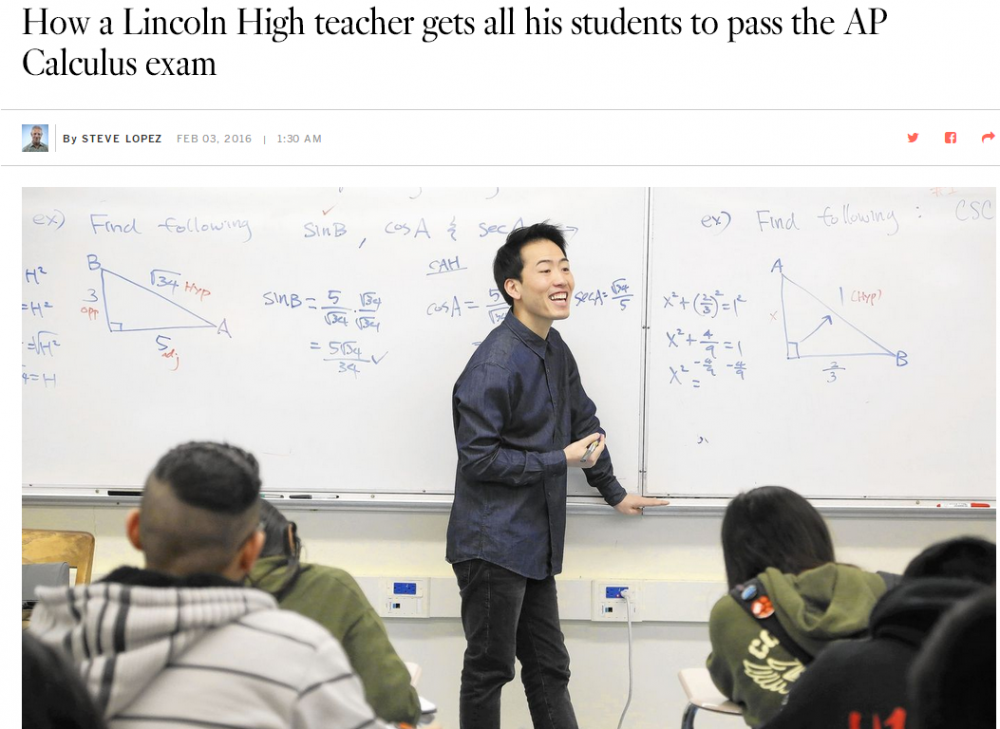
Legends happening on the east coast are equally inspiring. In 2016, at New York City's Success Academy schools, 95 percent of the students passed state math tests and 84 percent passed reading tests, and Success Academy schools occupied the list of top city schools in math proficiency. This achievement comes from a student group made up of 95 percent children of color and whose families have a median income of $32,000.

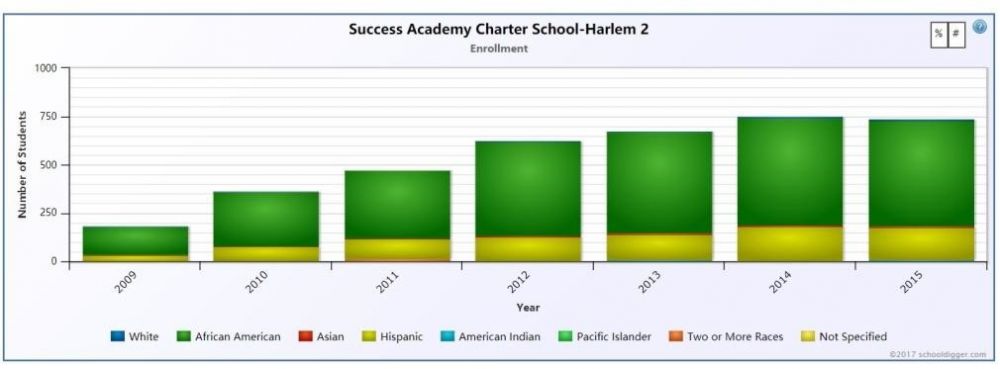
Big data analysis confirms that high expectations and high standards can dramatically enhance students' math performance. The pre-Common Core California math standards, written by Stanford mathematicians, were one of the highest state standards in America and internationally competitive as well. During the 15 years when they were in effect, California's Algebra 1 takers quadrupled to 67 percent in middle schools, and enrollment in Algebra 2 and Geometry more than doubled, with the biggest growth coming from disadvantaged minority students (Evers & Wurman, 2018). This is the most remarkable progress in narrowing the achievement gap that California has ever achieved in recent decades.
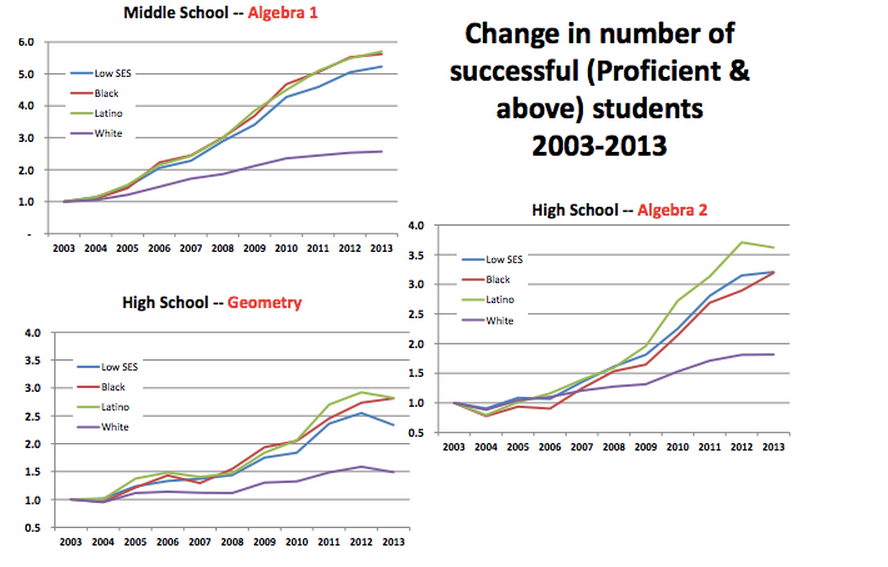
(source: Evers & Wurman, 2018)
In contrast, low expectations and lax standards will devastate students’ academic achievements in no time. Within a couple of years, the Common Core standards had destroyed the hard-won prize of narrowing the achievement gap: the number of eighth-grade Algebra 1 takers in California plunged to 19 percent in 2017, with the biggest dip falling upon Latino and African American students (Evers & Wurman, 2018).
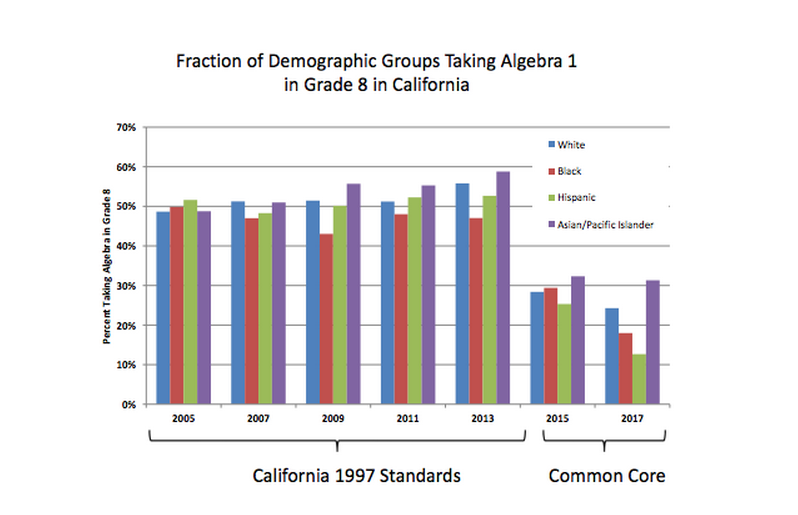
(source: Evers & Wurman, 2018)
The evidence above verifies that the road to salvage the dismal math performance of the American students and to narrow academic achievement gap is through high expectations, high standards, rigorous curricula, and teaching students content instead of teaching them nonsense. To close the achievement gap or to reduce stress through even weaker curriculum and lower academic standards, like clipping off the wings of eaglets, will commit the biggest social injustice to the disadvantaged students. If only the progressive educators would walk out of their comfort zone to adopt the internationally high-standard math programs, such as Singapore Math, and to give up the deceitful "higher-order thinking," "critical thinking" rhetoric, they would find that getting students to achieve arithmetic fluency, master algebra and geometry, and excel in higher-level math is not such a formidable task.
Those enthralling equity measures advocated by progressive educators—early childhood development, smaller class size, better technology, and new fads like brain science or personalized learning—serve more on their vying for government funds, winning public votes, or excusing themselves from public critiques than on narrowing the achievement gap. Studies show that the Head Start program, an early-childhood-support program launched in 1965 and having cost more than $180 billion, "has little to no impact on cognitive, social-emotional, health, or parenting practices of its participants. In fact, on a few measures, access to the program actually produced negative effects.”
Money or technology alone will not do much work either. The venerable Palo Altan Steve Jobs once commented,
I used to think that technology could help education. I've probably spearheaded giving away more computer equipment to schools than anybody else on the planet. But I've had to come to the inevitable conclusion that the problem is not one that technology can hope to solve. What's wrong with education cannot be fixed with technology. No amount of technology will make a dent.
Limiting access to honor or AP courses, banning weighted GPA, and other hurdles to hold back advanced kids are ineffective and unethical. Closing the achievement gap through such equity measures will not do any good to improve the bottom students' academic performance, but it will surely widen the achievement gap between the top American students and their peers in high-performing countries, threatening America's competitiveness in science and technology.
- Anti-intellectualism and Mediocre Education are Costly and Jeopardous
Poor math education threatens democracy in America. Math is the best tool to train one's logical reasoning ability. People with a weak logical reasoning ability are gullible to populist's instigation. A nation dominated by citizens with poor math literacy is jeopardized in defending democracy and liberty. As Tocqueville put it, it is easier for the world to accept a simple lie than a complex truth.
Poor math education is costly to individuals. According to Stanford economist Hanushek (2013), a student with achievement that is one standard deviation above average can expect to take in 10 to 15 percent higher earnings per year later in life, which amounts to an average increase of between $110,000 and $230,000 in lifetime earnings. Canadian mathematician Anna Stokke remarks, "Strong mathematics is required for success in the workforce, and early achievement in math is one of the best predictors of later academic success and future career options" (Stokke, 2015). Poor math education thus severely constrains the youth's future career options and financial success.
Poor public education is costly to America. Per estimates by Hanushek (2013), closing just half of the performance gap with the top international performers in terms of student achievement could add more than $70 trillion in present value to the U.S. GDP between 2010 and 2090. Thus, the achievement gap between the U.S. and the world's top-performing countries can be said to be causing the equivalent of a permanent recession.
Solid math mastery is also vital for supporting the youth's mental health. Because math is the foundation for all other STEM subjects, poor math skills will prolong students' homework time, impair self-esteem, and multiply academic stress through cascade effects. The consequences of academic stress can go beyond hurting mental health to triggering such misconduct as drug use, bullying, and pulling false fire alarms on campus. In an age of global competition, we should grow our youth's grit and resilience through high expectations, rigorous curriculum, and quality teaching starting from elementary grades. Fooling our children with deficient and diluted courses in K-8 grades is sowing seeds of incompetence and anxiety for their high school years and beyond.
Quality math education is also crucial for preserving social upward mobility and reducing crime. In the Ravenswood school district of East Palo Alto, only 17 percent and 12 percent of elementary students met or exceeded English and math state standards, respectively, and 50 percent of students did not graduate high school in 2016. High school dropouts commit roughly 75 percent of the crimes in America. As a Ravenswood parent warned, "When young people do not have pathways to opportunity, they can go down a very negative path that impacts everyone." Poor public education is itself a crime to beget future crimes.
In the coming decade, the share of minority students—many from a disadvantaged socioeconomic background—in the 15,000 American public school districts will be approaching 50 percent. If we allow those anti-intellectual, dysfunctional educational fads to continue to mislead the American public schools, and if we cannot genuinely close the achievement gap by teaching all children with rigorous, content-based subjects, we will jeopardize America as a land of hope and liberty.
- Concluding Remarks
In human history, it is rare to see a school of false theories and doctrines prevail in a democratic society for such an ultra long time and afflict such a sizable population. Unfortunately, the century-long prevalence of progressive education in American schools exemplifies such a rare case, which echoes the oracle of George Orwell hidden in his 1984: "The familiar pendulum swing was to happen once more, and then stop."
While Rousseau's absolute equality, direct democracy, and collectivism inspired Robespierre to guillotine tens of thousands of people during the Reign of Terror of the French Revolution, the American progressive education model, scaffolded upon Rousseau's political and pedagogical progressivism, has been tragically guillotining the intellectual capacities of millions of American students through its Reign of Error, without a stain of blood, year after year, generation after generation.
Supported by the prestigious Stanford education school scholars, the San Francisco school district has banned Algebra 1 in all middle schools since four years ago, and more school districts are contemplating it. In Cambridge, Massachusetts, the Cambridge Public Schools just recently adopted Illustrative Mathematics--another Fuzzy Math curriculum--for their middle schools, dropping Singapore Mathematics (Math in Focus) and the Advanced Math Pathway, the accelerated lane for advanced students. While the tasks of closing the achievement gap and reducing stress have become more pressing, anti-intellectualism is fermenting in the air of Palo Alto. Adopting weak textbooks, limiting access to AP courses, eliminating weighted GPAs, discouraging grade-skipping, and de-lane--these are measures to equalize students' academic performance through squashing the top-performing students down instead of striving to bring the bottom students up. Such equity measures are unethical, irresponsible, and wrong-headed. They are against the notion of equality of the Declaration of Independence. As Hayek put it, radical equality is a road to serfdom.
Palo Alto is at a crossroad. How far will the anti-intellectualism go in Palo Alto? For how long will the Reign of Error endure in American schools?

Reference:
Bishop, W. (2017) Significance of PISA math results, Retrieved from
https://nonpartisaneducation.org/blog1/2017/01/02/significance-of-pisa-math-results/
Evers, W. and Z. Wurman (2018), California's Common Core Mistake. Retrieved from
https://www.hoover.org/research/californias-common-core-mistake
Hanushek, E. A., et al. (2013), Returns to Skills Around the World: Evidence from PIAAC, OECD Education Working Papers, No. 101, OECD Publishing
Klein, D. (2001), A Brief History of American K-12 Mathematics Education in the 20th Century. http://www.csun.edu/~vcmth00m/
Klein, D. (2003), A quarter century of US 'math wars' and political partisanship.
http://www.csun.edu/~vcmth00m/
Lopez, S. (2016), How a Lincoln High teacher gets all his students to pass the AP Calculus exam. Retrieved from
http://www.latimes.com/local/california/la-me-0103-lopez-yom-teacher-20160201-column.html
Milgram, J. & Stotsky, S. (2013), Lowering the bar, how common core math fails to prepare high school students for STEM. Retrieved from
Ma, L. (1999), Knowing and Teaching Elementary Mathematics, Lawrence Erlbaum Associates, Publishers.
Ratner, M. (2013), Making Math Education Even Worse. Retrieved from
http://www.wsj.com/articles/marinaratnermakingmatheducationevenworse1407283282
NCEE (2013), What Does It Really Mean To Be College And Work Ready? Retrieved from http://ncee.org/college-and-work-ready/
Ravitch, D. (2000), Hard Lessons, an interview with Atlantic Unbound. Retrieved from
https://www.theatlantic.com/past/docs/unbound/interviews/ba2000-11-01.htm
Stokke, A. (2015), What to Do about Canada's Declining Math Scores, Institut C.D. HOWE Institute commentary NO. 427 Retrieved from
https://www.cdhowe.org/sites/default/files/attachments/research_papers/mixed/commentary_427.pdf
Tarvenan, K. and S. Kivelä (2005), Severe shortcomings in Finnish mathematics skills. Retrieved from
https://matematiikkalehtisolmu.fi/2005/erik/KivTarEng.html




